Waste Management Report: Construction Waste and Environmental Impact
VerifiedAdded on 2020/04/15
|8
|2046
|37
Report
AI Summary
This report comprehensively examines waste management practices within the construction industry. It begins with an introduction to the generation of waste and its impact on the environment, differentiating between urban and rural contexts. The report then categorizes waste into liquid, solid, organic, and hazardous types, providing examples and discussing their unique characteristics and management strategies. The report details waste collection procedures, emphasizing the roles of various site personnel and the use of designated collection bins. It explores various disposal methods, including landfilling, incineration, and biological reprocessing, evaluating their effectiveness and environmental impacts. The report also addresses waste reduction principles such as waste hierarchy and the 'polluter pays' principle, emphasizing the roles of contractors and subcontractors in sustainable waste management. Safety protocols for waste crews and the importance of adhering to relevant laws and regulations are also discussed, including waste classification and treatment methods. The report concludes by highlighting the significance of responsible waste management practices for environmental protection and public health.
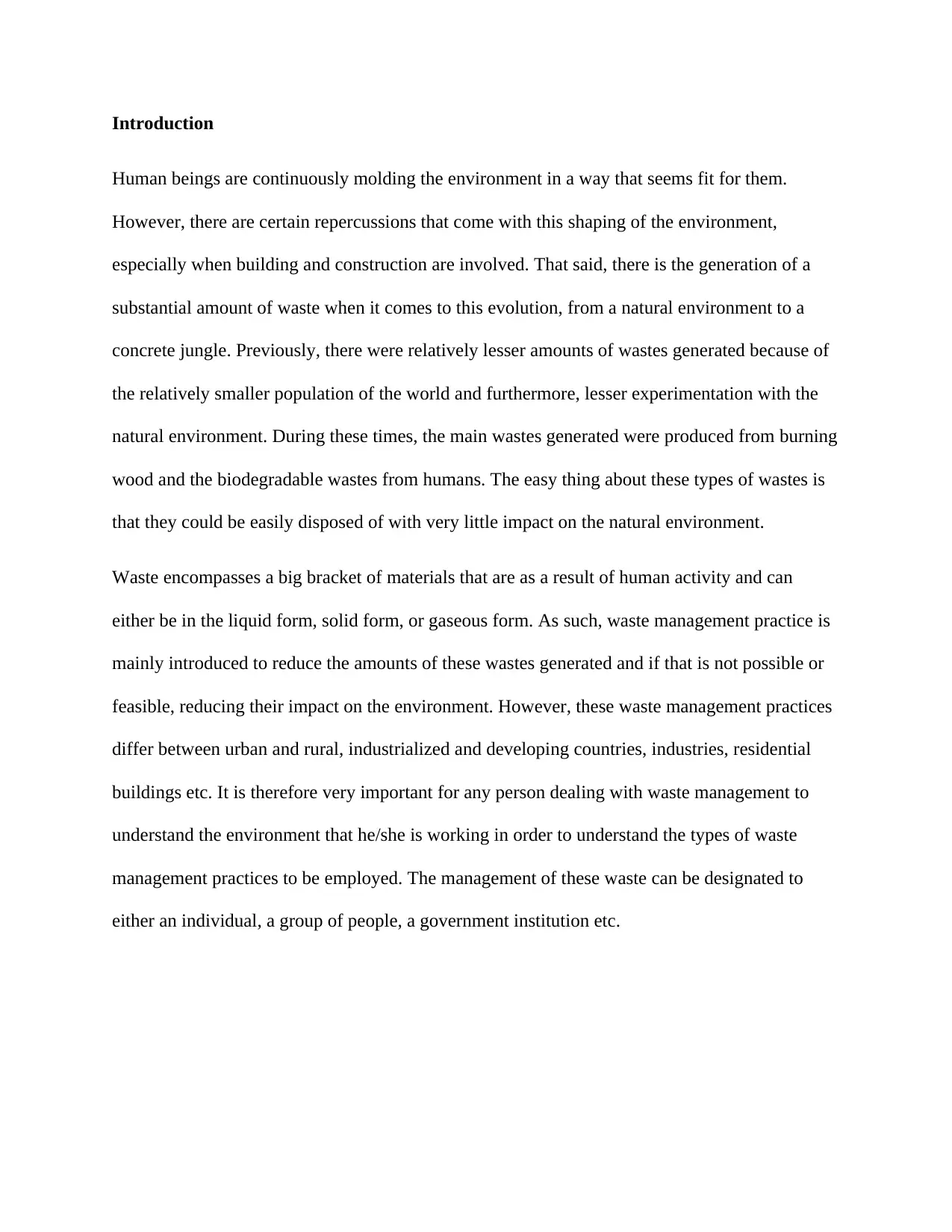
Introduction
Human beings are continuously molding the environment in a way that seems fit for them.
However, there are certain repercussions that come with this shaping of the environment,
especially when building and construction are involved. That said, there is the generation of a
substantial amount of waste when it comes to this evolution, from a natural environment to a
concrete jungle. Previously, there were relatively lesser amounts of wastes generated because of
the relatively smaller population of the world and furthermore, lesser experimentation with the
natural environment. During these times, the main wastes generated were produced from burning
wood and the biodegradable wastes from humans. The easy thing about these types of wastes is
that they could be easily disposed of with very little impact on the natural environment.
Waste encompasses a big bracket of materials that are as a result of human activity and can
either be in the liquid form, solid form, or gaseous form. As such, waste management practice is
mainly introduced to reduce the amounts of these wastes generated and if that is not possible or
feasible, reducing their impact on the environment. However, these waste management practices
differ between urban and rural, industrialized and developing countries, industries, residential
buildings etc. It is therefore very important for any person dealing with waste management to
understand the environment that he/she is working in order to understand the types of waste
management practices to be employed. The management of these waste can be designated to
either an individual, a group of people, a government institution etc.
Human beings are continuously molding the environment in a way that seems fit for them.
However, there are certain repercussions that come with this shaping of the environment,
especially when building and construction are involved. That said, there is the generation of a
substantial amount of waste when it comes to this evolution, from a natural environment to a
concrete jungle. Previously, there were relatively lesser amounts of wastes generated because of
the relatively smaller population of the world and furthermore, lesser experimentation with the
natural environment. During these times, the main wastes generated were produced from burning
wood and the biodegradable wastes from humans. The easy thing about these types of wastes is
that they could be easily disposed of with very little impact on the natural environment.
Waste encompasses a big bracket of materials that are as a result of human activity and can
either be in the liquid form, solid form, or gaseous form. As such, waste management practice is
mainly introduced to reduce the amounts of these wastes generated and if that is not possible or
feasible, reducing their impact on the environment. However, these waste management practices
differ between urban and rural, industrialized and developing countries, industries, residential
buildings etc. It is therefore very important for any person dealing with waste management to
understand the environment that he/she is working in order to understand the types of waste
management practices to be employed. The management of these waste can be designated to
either an individual, a group of people, a government institution etc.
Paraphrase This Document
Need a fresh take? Get an instant paraphrase of this document with our AI Paraphraser
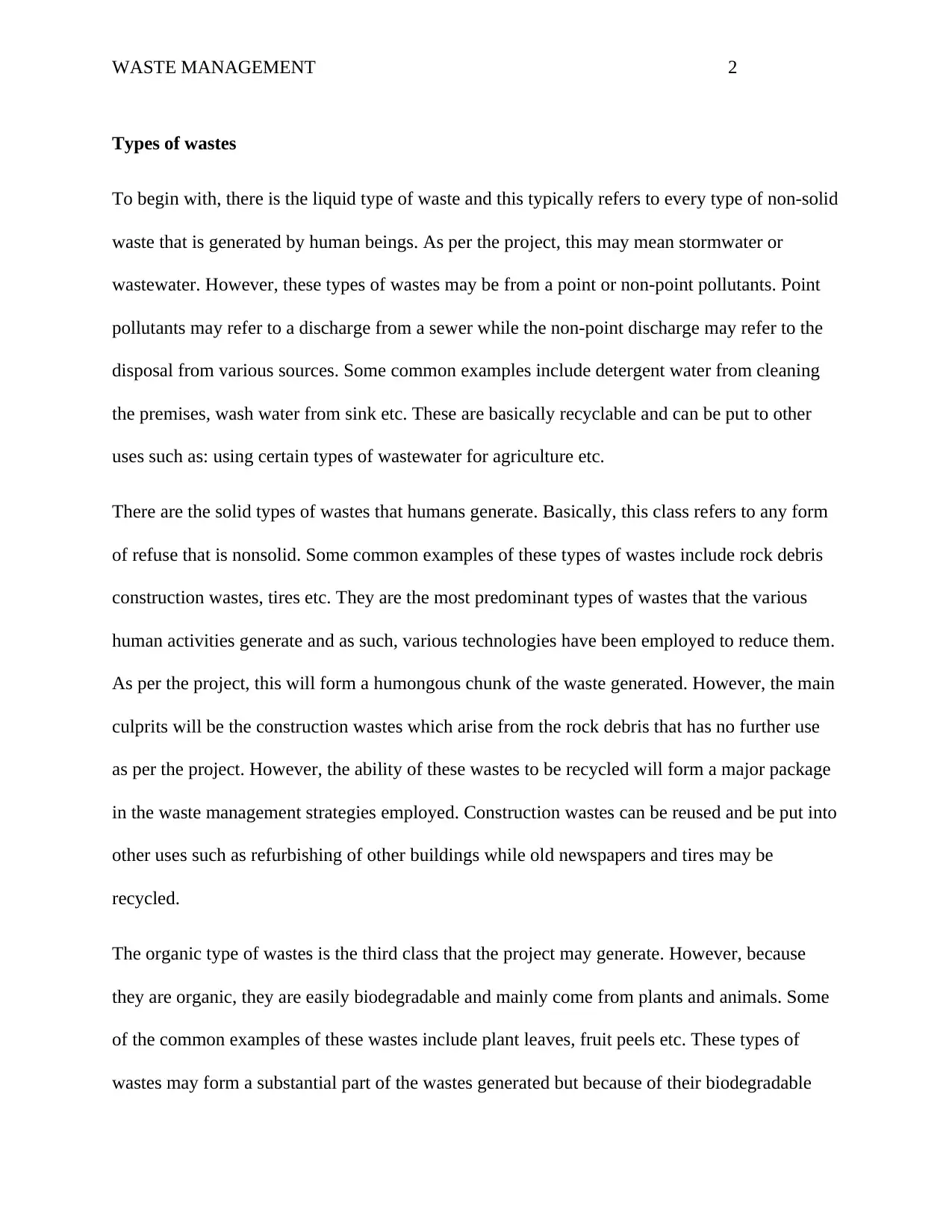
WASTE MANAGEMENT 2
Types of wastes
To begin with, there is the liquid type of waste and this typically refers to every type of non-solid
waste that is generated by human beings. As per the project, this may mean stormwater or
wastewater. However, these types of wastes may be from a point or non-point pollutants. Point
pollutants may refer to a discharge from a sewer while the non-point discharge may refer to the
disposal from various sources. Some common examples include detergent water from cleaning
the premises, wash water from sink etc. These are basically recyclable and can be put to other
uses such as: using certain types of wastewater for agriculture etc.
There are the solid types of wastes that humans generate. Basically, this class refers to any form
of refuse that is nonsolid. Some common examples of these types of wastes include rock debris
construction wastes, tires etc. They are the most predominant types of wastes that the various
human activities generate and as such, various technologies have been employed to reduce them.
As per the project, this will form a humongous chunk of the waste generated. However, the main
culprits will be the construction wastes which arise from the rock debris that has no further use
as per the project. However, the ability of these wastes to be recycled will form a major package
in the waste management strategies employed. Construction wastes can be reused and be put into
other uses such as refurbishing of other buildings while old newspapers and tires may be
recycled.
The organic type of wastes is the third class that the project may generate. However, because
they are organic, they are easily biodegradable and mainly come from plants and animals. Some
of the common examples of these wastes include plant leaves, fruit peels etc. These types of
wastes may form a substantial part of the wastes generated but because of their biodegradable
Types of wastes
To begin with, there is the liquid type of waste and this typically refers to every type of non-solid
waste that is generated by human beings. As per the project, this may mean stormwater or
wastewater. However, these types of wastes may be from a point or non-point pollutants. Point
pollutants may refer to a discharge from a sewer while the non-point discharge may refer to the
disposal from various sources. Some common examples include detergent water from cleaning
the premises, wash water from sink etc. These are basically recyclable and can be put to other
uses such as: using certain types of wastewater for agriculture etc.
There are the solid types of wastes that humans generate. Basically, this class refers to any form
of refuse that is nonsolid. Some common examples of these types of wastes include rock debris
construction wastes, tires etc. They are the most predominant types of wastes that the various
human activities generate and as such, various technologies have been employed to reduce them.
As per the project, this will form a humongous chunk of the waste generated. However, the main
culprits will be the construction wastes which arise from the rock debris that has no further use
as per the project. However, the ability of these wastes to be recycled will form a major package
in the waste management strategies employed. Construction wastes can be reused and be put into
other uses such as refurbishing of other buildings while old newspapers and tires may be
recycled.
The organic type of wastes is the third class that the project may generate. However, because
they are organic, they are easily biodegradable and mainly come from plants and animals. Some
of the common examples of these wastes include plant leaves, fruit peels etc. These types of
wastes may form a substantial part of the wastes generated but because of their biodegradable
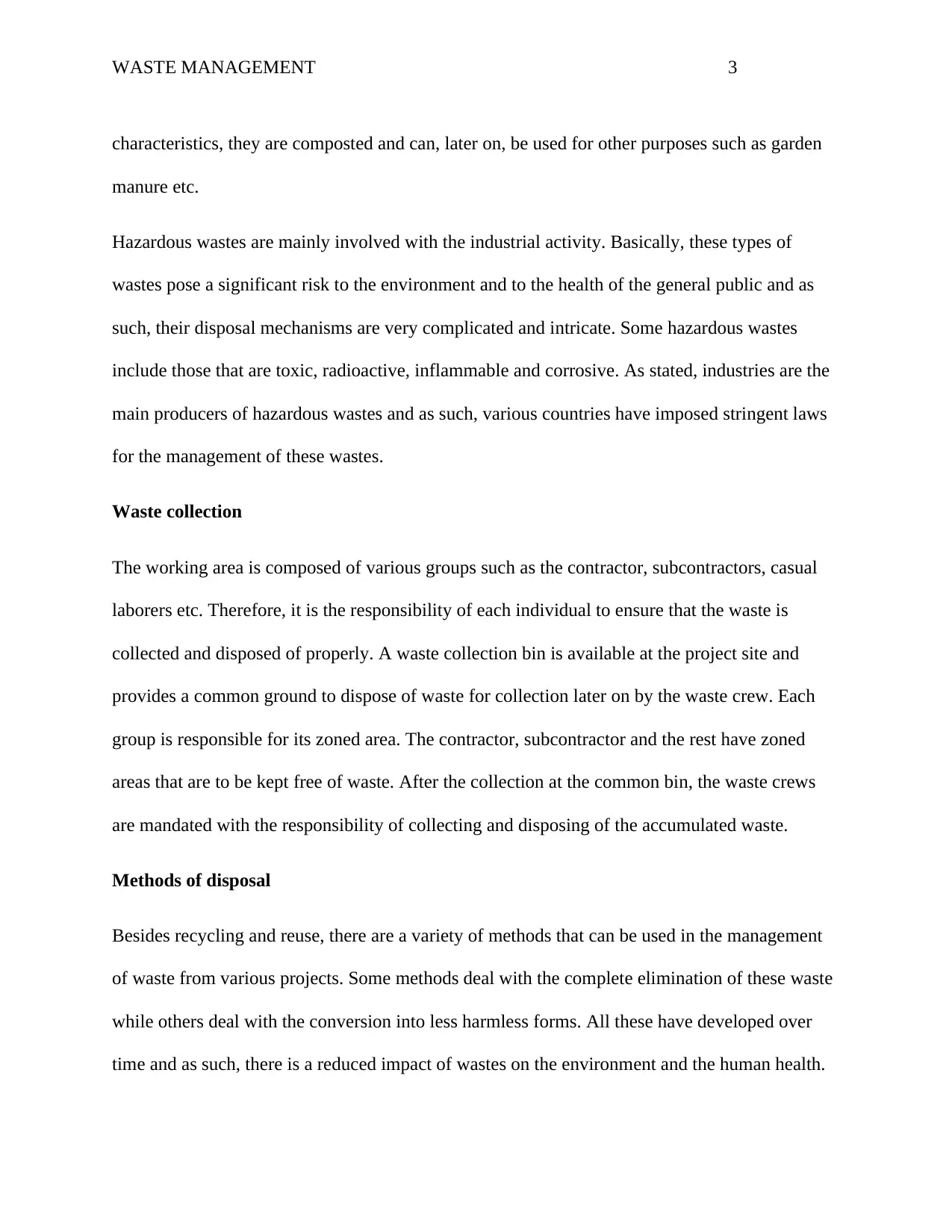
WASTE MANAGEMENT 3
characteristics, they are composted and can, later on, be used for other purposes such as garden
manure etc.
Hazardous wastes are mainly involved with the industrial activity. Basically, these types of
wastes pose a significant risk to the environment and to the health of the general public and as
such, their disposal mechanisms are very complicated and intricate. Some hazardous wastes
include those that are toxic, radioactive, inflammable and corrosive. As stated, industries are the
main producers of hazardous wastes and as such, various countries have imposed stringent laws
for the management of these wastes.
Waste collection
The working area is composed of various groups such as the contractor, subcontractors, casual
laborers etc. Therefore, it is the responsibility of each individual to ensure that the waste is
collected and disposed of properly. A waste collection bin is available at the project site and
provides a common ground to dispose of waste for collection later on by the waste crew. Each
group is responsible for its zoned area. The contractor, subcontractor and the rest have zoned
areas that are to be kept free of waste. After the collection at the common bin, the waste crews
are mandated with the responsibility of collecting and disposing of the accumulated waste.
Methods of disposal
Besides recycling and reuse, there are a variety of methods that can be used in the management
of waste from various projects. Some methods deal with the complete elimination of these waste
while others deal with the conversion into less harmless forms. All these have developed over
time and as such, there is a reduced impact of wastes on the environment and the human health.
characteristics, they are composted and can, later on, be used for other purposes such as garden
manure etc.
Hazardous wastes are mainly involved with the industrial activity. Basically, these types of
wastes pose a significant risk to the environment and to the health of the general public and as
such, their disposal mechanisms are very complicated and intricate. Some hazardous wastes
include those that are toxic, radioactive, inflammable and corrosive. As stated, industries are the
main producers of hazardous wastes and as such, various countries have imposed stringent laws
for the management of these wastes.
Waste collection
The working area is composed of various groups such as the contractor, subcontractors, casual
laborers etc. Therefore, it is the responsibility of each individual to ensure that the waste is
collected and disposed of properly. A waste collection bin is available at the project site and
provides a common ground to dispose of waste for collection later on by the waste crew. Each
group is responsible for its zoned area. The contractor, subcontractor and the rest have zoned
areas that are to be kept free of waste. After the collection at the common bin, the waste crews
are mandated with the responsibility of collecting and disposing of the accumulated waste.
Methods of disposal
Besides recycling and reuse, there are a variety of methods that can be used in the management
of waste from various projects. Some methods deal with the complete elimination of these waste
while others deal with the conversion into less harmless forms. All these have developed over
time and as such, there is a reduced impact of wastes on the environment and the human health.
⊘ This is a preview!⊘
Do you want full access?
Subscribe today to unlock all pages.

Trusted by 1+ million students worldwide
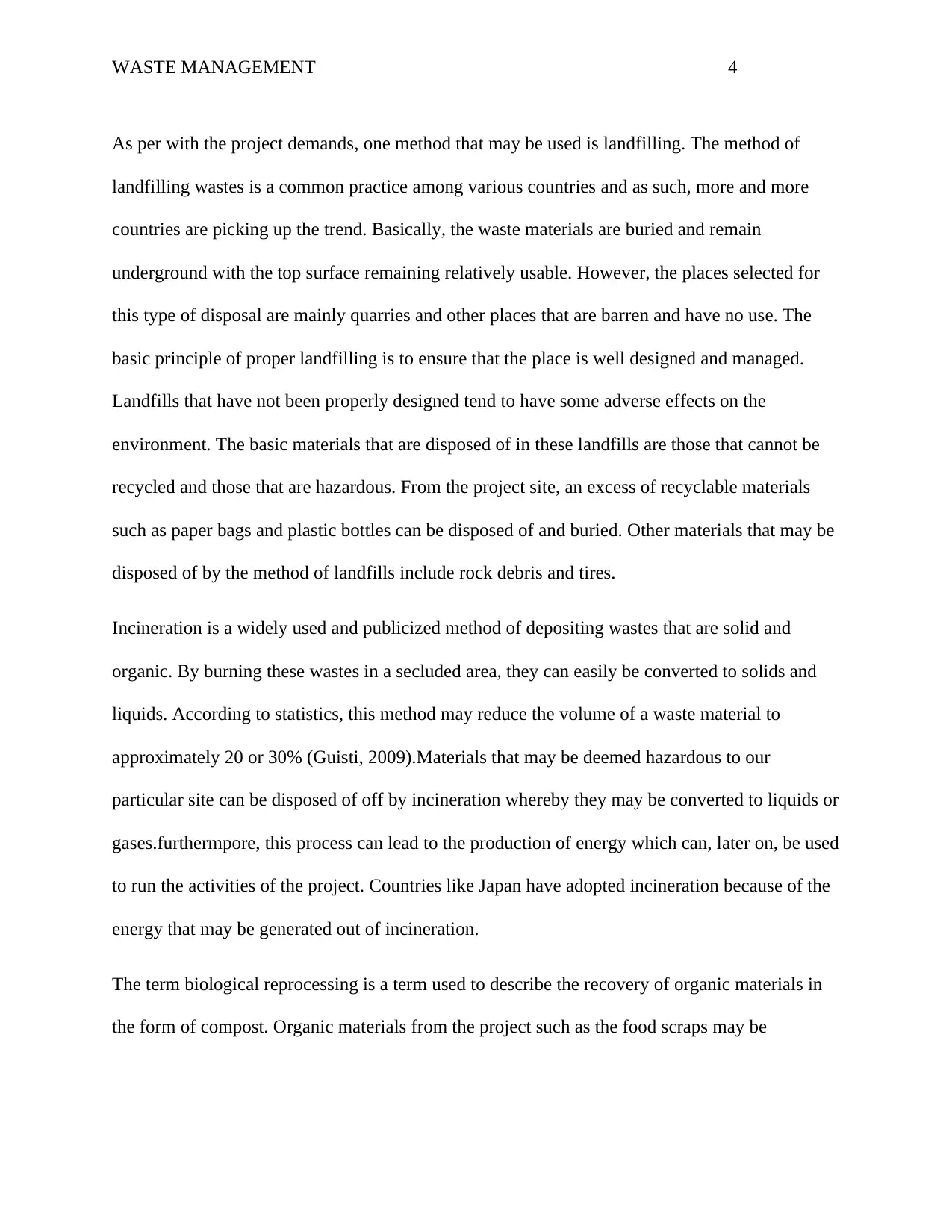
WASTE MANAGEMENT 4
As per with the project demands, one method that may be used is landfilling. The method of
landfilling wastes is a common practice among various countries and as such, more and more
countries are picking up the trend. Basically, the waste materials are buried and remain
underground with the top surface remaining relatively usable. However, the places selected for
this type of disposal are mainly quarries and other places that are barren and have no use. The
basic principle of proper landfilling is to ensure that the place is well designed and managed.
Landfills that have not been properly designed tend to have some adverse effects on the
environment. The basic materials that are disposed of in these landfills are those that cannot be
recycled and those that are hazardous. From the project site, an excess of recyclable materials
such as paper bags and plastic bottles can be disposed of and buried. Other materials that may be
disposed of by the method of landfills include rock debris and tires.
Incineration is a widely used and publicized method of depositing wastes that are solid and
organic. By burning these wastes in a secluded area, they can easily be converted to solids and
liquids. According to statistics, this method may reduce the volume of a waste material to
approximately 20 or 30% (Guisti, 2009).Materials that may be deemed hazardous to our
particular site can be disposed of off by incineration whereby they may be converted to liquids or
gases.furthermpore, this process can lead to the production of energy which can, later on, be used
to run the activities of the project. Countries like Japan have adopted incineration because of the
energy that may be generated out of incineration.
The term biological reprocessing is a term used to describe the recovery of organic materials in
the form of compost. Organic materials from the project such as the food scraps may be
As per with the project demands, one method that may be used is landfilling. The method of
landfilling wastes is a common practice among various countries and as such, more and more
countries are picking up the trend. Basically, the waste materials are buried and remain
underground with the top surface remaining relatively usable. However, the places selected for
this type of disposal are mainly quarries and other places that are barren and have no use. The
basic principle of proper landfilling is to ensure that the place is well designed and managed.
Landfills that have not been properly designed tend to have some adverse effects on the
environment. The basic materials that are disposed of in these landfills are those that cannot be
recycled and those that are hazardous. From the project site, an excess of recyclable materials
such as paper bags and plastic bottles can be disposed of and buried. Other materials that may be
disposed of by the method of landfills include rock debris and tires.
Incineration is a widely used and publicized method of depositing wastes that are solid and
organic. By burning these wastes in a secluded area, they can easily be converted to solids and
liquids. According to statistics, this method may reduce the volume of a waste material to
approximately 20 or 30% (Guisti, 2009).Materials that may be deemed hazardous to our
particular site can be disposed of off by incineration whereby they may be converted to liquids or
gases.furthermpore, this process can lead to the production of energy which can, later on, be used
to run the activities of the project. Countries like Japan have adopted incineration because of the
energy that may be generated out of incineration.
The term biological reprocessing is a term used to describe the recovery of organic materials in
the form of compost. Organic materials from the project such as the food scraps may be
Paraphrase This Document
Need a fresh take? Get an instant paraphrase of this document with our AI Paraphraser
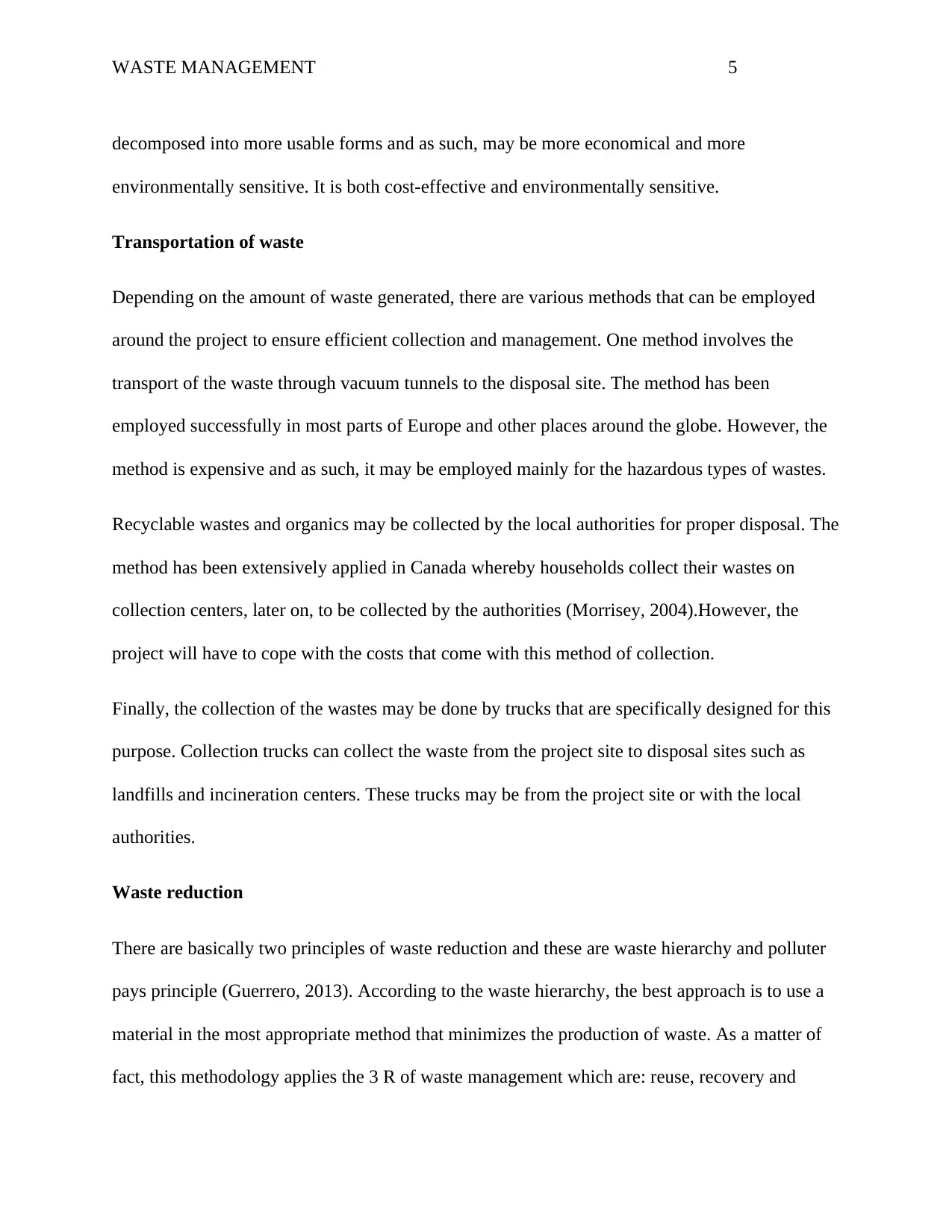
WASTE MANAGEMENT 5
decomposed into more usable forms and as such, may be more economical and more
environmentally sensitive. It is both cost-effective and environmentally sensitive.
Transportation of waste
Depending on the amount of waste generated, there are various methods that can be employed
around the project to ensure efficient collection and management. One method involves the
transport of the waste through vacuum tunnels to the disposal site. The method has been
employed successfully in most parts of Europe and other places around the globe. However, the
method is expensive and as such, it may be employed mainly for the hazardous types of wastes.
Recyclable wastes and organics may be collected by the local authorities for proper disposal. The
method has been extensively applied in Canada whereby households collect their wastes on
collection centers, later on, to be collected by the authorities (Morrisey, 2004).However, the
project will have to cope with the costs that come with this method of collection.
Finally, the collection of the wastes may be done by trucks that are specifically designed for this
purpose. Collection trucks can collect the waste from the project site to disposal sites such as
landfills and incineration centers. These trucks may be from the project site or with the local
authorities.
Waste reduction
There are basically two principles of waste reduction and these are waste hierarchy and polluter
pays principle (Guerrero, 2013). According to the waste hierarchy, the best approach is to use a
material in the most appropriate method that minimizes the production of waste. As a matter of
fact, this methodology applies the 3 R of waste management which are: reuse, recovery and
decomposed into more usable forms and as such, may be more economical and more
environmentally sensitive. It is both cost-effective and environmentally sensitive.
Transportation of waste
Depending on the amount of waste generated, there are various methods that can be employed
around the project to ensure efficient collection and management. One method involves the
transport of the waste through vacuum tunnels to the disposal site. The method has been
employed successfully in most parts of Europe and other places around the globe. However, the
method is expensive and as such, it may be employed mainly for the hazardous types of wastes.
Recyclable wastes and organics may be collected by the local authorities for proper disposal. The
method has been extensively applied in Canada whereby households collect their wastes on
collection centers, later on, to be collected by the authorities (Morrisey, 2004).However, the
project will have to cope with the costs that come with this method of collection.
Finally, the collection of the wastes may be done by trucks that are specifically designed for this
purpose. Collection trucks can collect the waste from the project site to disposal sites such as
landfills and incineration centers. These trucks may be from the project site or with the local
authorities.
Waste reduction
There are basically two principles of waste reduction and these are waste hierarchy and polluter
pays principle (Guerrero, 2013). According to the waste hierarchy, the best approach is to use a
material in the most appropriate method that minimizes the production of waste. As a matter of
fact, this methodology applies the 3 R of waste management which are: reuse, recovery and
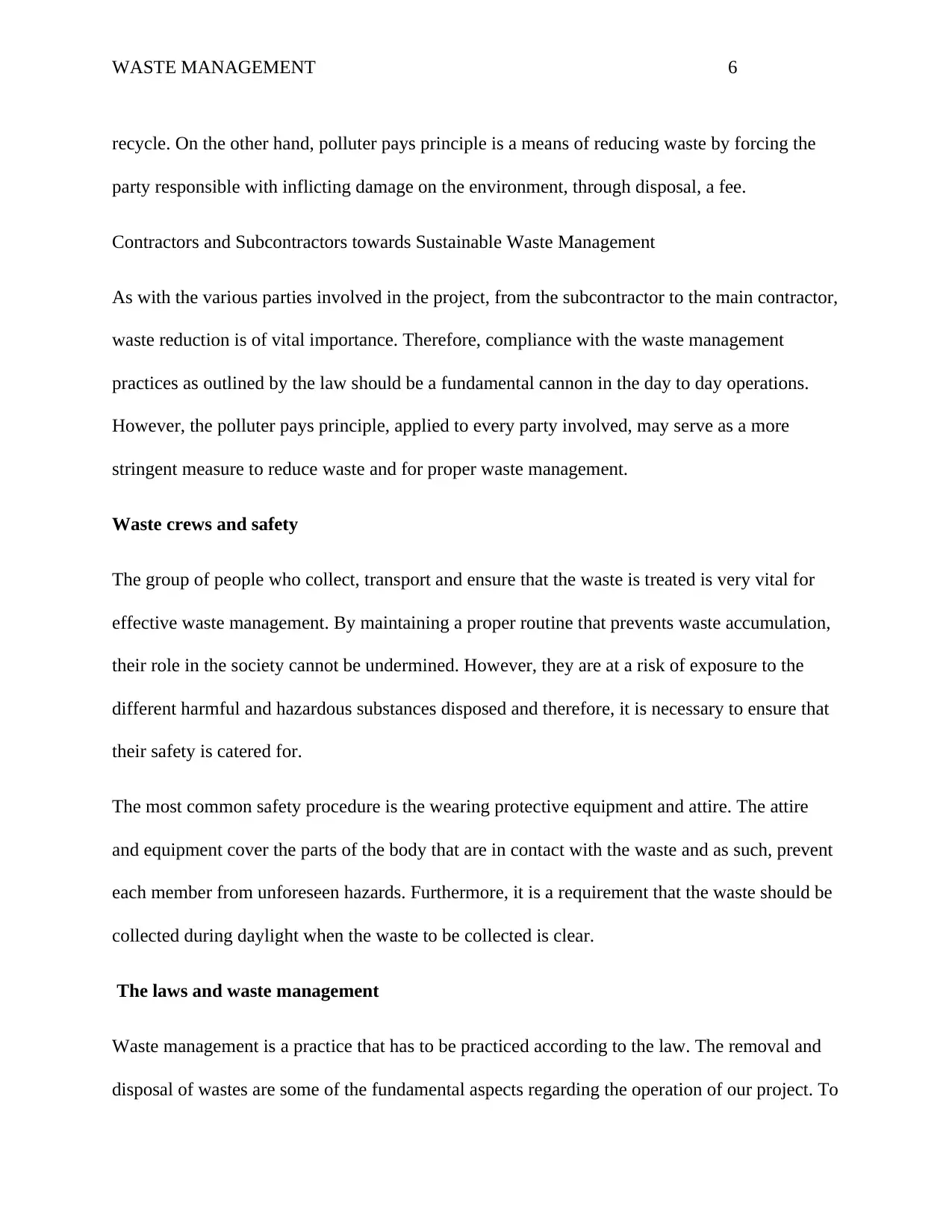
WASTE MANAGEMENT 6
recycle. On the other hand, polluter pays principle is a means of reducing waste by forcing the
party responsible with inflicting damage on the environment, through disposal, a fee.
Contractors and Subcontractors towards Sustainable Waste Management
As with the various parties involved in the project, from the subcontractor to the main contractor,
waste reduction is of vital importance. Therefore, compliance with the waste management
practices as outlined by the law should be a fundamental cannon in the day to day operations.
However, the polluter pays principle, applied to every party involved, may serve as a more
stringent measure to reduce waste and for proper waste management.
Waste crews and safety
The group of people who collect, transport and ensure that the waste is treated is very vital for
effective waste management. By maintaining a proper routine that prevents waste accumulation,
their role in the society cannot be undermined. However, they are at a risk of exposure to the
different harmful and hazardous substances disposed and therefore, it is necessary to ensure that
their safety is catered for.
The most common safety procedure is the wearing protective equipment and attire. The attire
and equipment cover the parts of the body that are in contact with the waste and as such, prevent
each member from unforeseen hazards. Furthermore, it is a requirement that the waste should be
collected during daylight when the waste to be collected is clear.
The laws and waste management
Waste management is a practice that has to be practiced according to the law. The removal and
disposal of wastes are some of the fundamental aspects regarding the operation of our project. To
recycle. On the other hand, polluter pays principle is a means of reducing waste by forcing the
party responsible with inflicting damage on the environment, through disposal, a fee.
Contractors and Subcontractors towards Sustainable Waste Management
As with the various parties involved in the project, from the subcontractor to the main contractor,
waste reduction is of vital importance. Therefore, compliance with the waste management
practices as outlined by the law should be a fundamental cannon in the day to day operations.
However, the polluter pays principle, applied to every party involved, may serve as a more
stringent measure to reduce waste and for proper waste management.
Waste crews and safety
The group of people who collect, transport and ensure that the waste is treated is very vital for
effective waste management. By maintaining a proper routine that prevents waste accumulation,
their role in the society cannot be undermined. However, they are at a risk of exposure to the
different harmful and hazardous substances disposed and therefore, it is necessary to ensure that
their safety is catered for.
The most common safety procedure is the wearing protective equipment and attire. The attire
and equipment cover the parts of the body that are in contact with the waste and as such, prevent
each member from unforeseen hazards. Furthermore, it is a requirement that the waste should be
collected during daylight when the waste to be collected is clear.
The laws and waste management
Waste management is a practice that has to be practiced according to the law. The removal and
disposal of wastes are some of the fundamental aspects regarding the operation of our project. To
⊘ This is a preview!⊘
Do you want full access?
Subscribe today to unlock all pages.

Trusted by 1+ million students worldwide
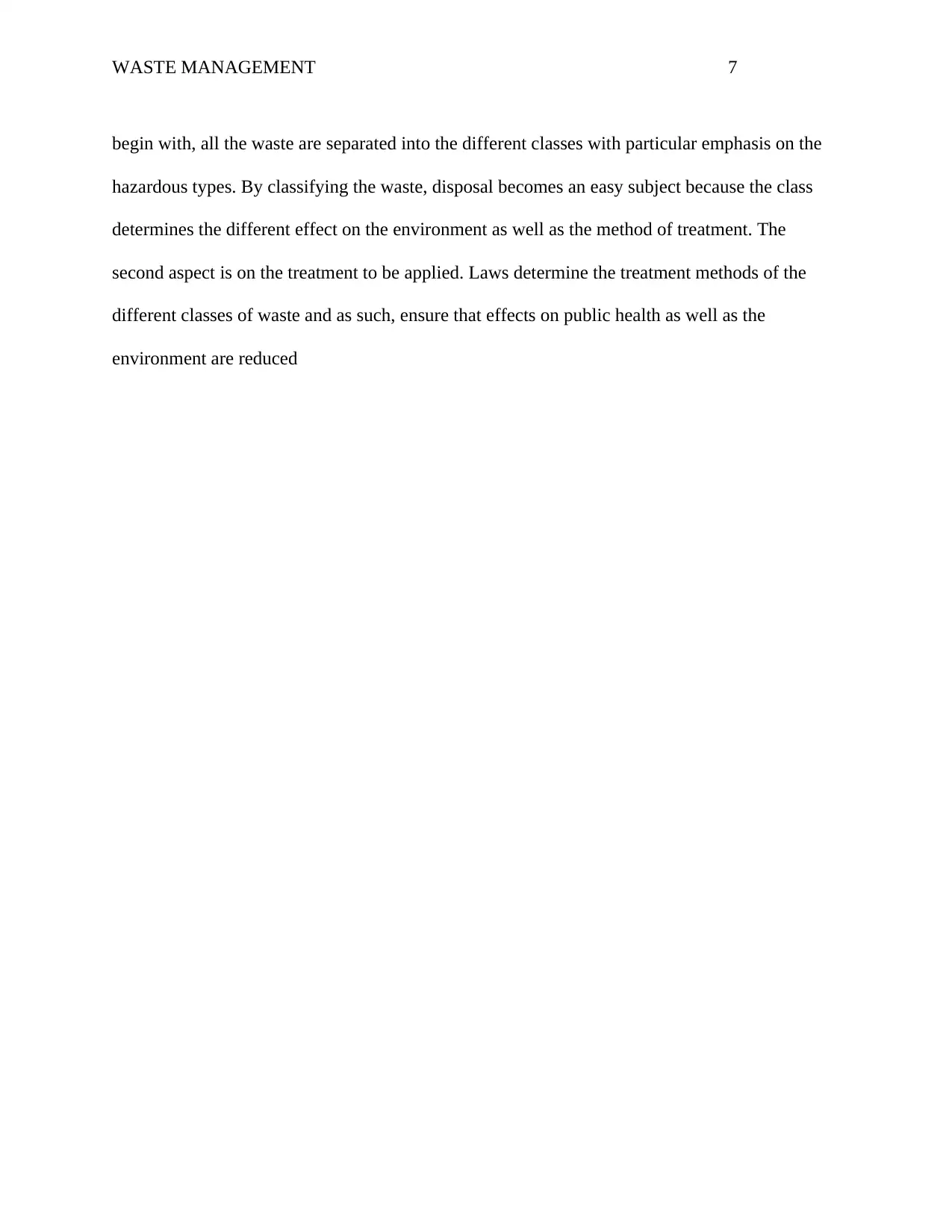
WASTE MANAGEMENT 7
begin with, all the waste are separated into the different classes with particular emphasis on the
hazardous types. By classifying the waste, disposal becomes an easy subject because the class
determines the different effect on the environment as well as the method of treatment. The
second aspect is on the treatment to be applied. Laws determine the treatment methods of the
different classes of waste and as such, ensure that effects on public health as well as the
environment are reduced
begin with, all the waste are separated into the different classes with particular emphasis on the
hazardous types. By classifying the waste, disposal becomes an easy subject because the class
determines the different effect on the environment as well as the method of treatment. The
second aspect is on the treatment to be applied. Laws determine the treatment methods of the
different classes of waste and as such, ensure that effects on public health as well as the
environment are reduced
Paraphrase This Document
Need a fresh take? Get an instant paraphrase of this document with our AI Paraphraser
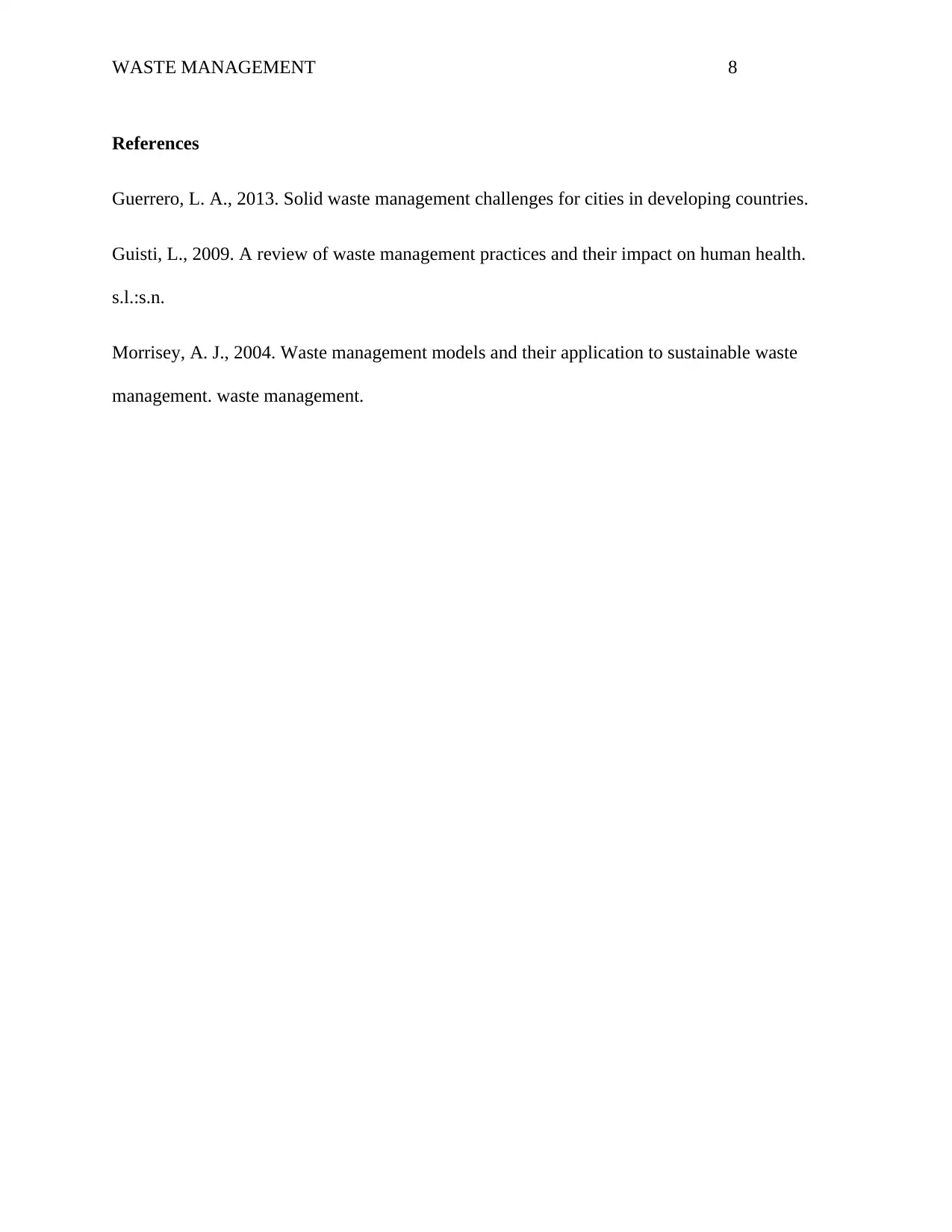
WASTE MANAGEMENT 8
References
Guerrero, L. A., 2013. Solid waste management challenges for cities in developing countries.
Guisti, L., 2009. A review of waste management practices and their impact on human health.
s.l.:s.n.
Morrisey, A. J., 2004. Waste management models and their application to sustainable waste
management. waste management.
References
Guerrero, L. A., 2013. Solid waste management challenges for cities in developing countries.
Guisti, L., 2009. A review of waste management practices and their impact on human health.
s.l.:s.n.
Morrisey, A. J., 2004. Waste management models and their application to sustainable waste
management. waste management.
1 out of 8
Related Documents
Your All-in-One AI-Powered Toolkit for Academic Success.
+13062052269
info@desklib.com
Available 24*7 on WhatsApp / Email
![[object Object]](/_next/static/media/star-bottom.7253800d.svg)
Unlock your academic potential
Copyright © 2020–2025 A2Z Services. All Rights Reserved. Developed and managed by ZUCOL.





